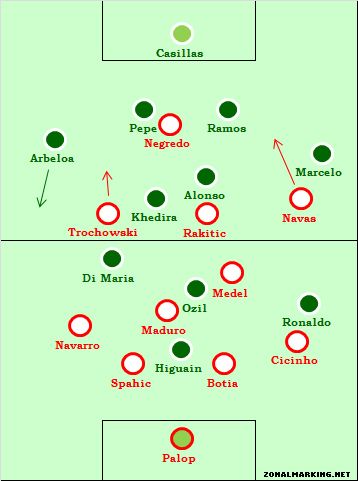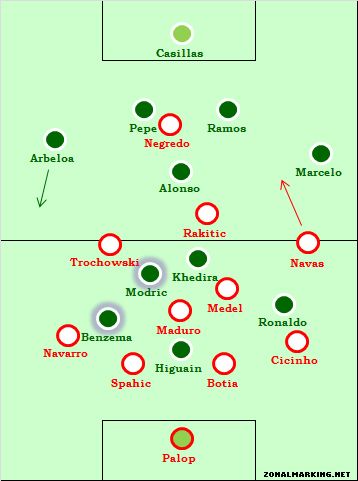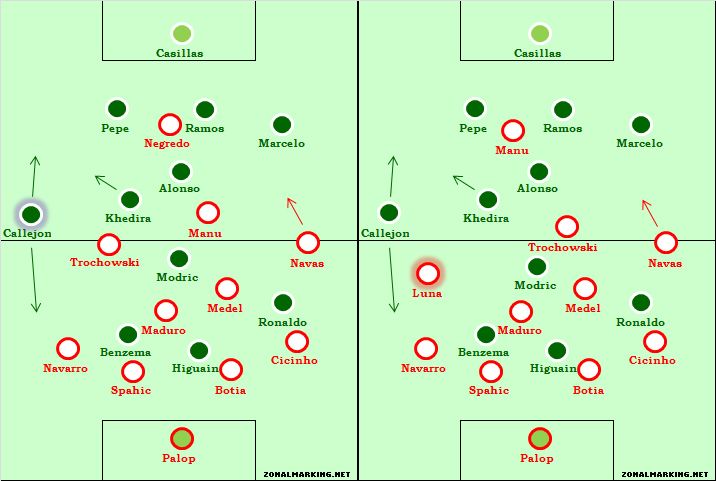juventus1980
Member
- Joined
- Nov 15, 2011
- Messages
- 149
- Reaction score
- 0
- Points
- 0
[h=1]Sevilla 1-0 Real Madrid: Sevilla score after 2 minutes, then protect the lead for 88September 16, 2012
 The starting line-ups
The starting line-ups
Sevilla triumphed in a fascinating tactical battle at the Estadio Ramon Sanchez Pizjuan.
Sevilla coach Michel made an interesting selection decision, introducing Hedwiges Maduro into the midfield triangle. This pushed Piotr Trochowski forward to the left, and meant Manu had to settle for a place on the bench.
Jose Mourinho chose a familiar side, with Luka Modric on the bench. Gonzalo Higuain started ahead of Karim Benzema upfront.
There were two major phases to this game ? the first half was about how well Sevilla?s initial gameplan worked, the second half was about how Mourinho adapted, and then the two coaches traded blows with substitutions until the end.
Sevilla tactic 1: early pressure
First, though, it must be said that Sevilla had an excellent early spell of pressure, and there was always an attacking intent at 1-0 up, albeit mainly on the counter-attack.
They started the game strongly with a physical, energetic approach across the pitch, which was their first key defensive feature. 34 tackles and 21 fouls tells the story ? they closed down quickly, won the ball aggressively and immediately launched direct attacks. Iker Casillas had already been forced into a good save before Trochowski, completely unmarked from a set-piece (a feature of Real?s defending the first half), fired Sevilla into an early lead.
From then, Sevilla?s threat mainly involved Alvaro Negredo working the channels, and flicking the ball onto Jesus Navas, who was a constant danger down the right with his sheer pace. Essentially, this method of attack remained the same throughout the game ? or, rather, until Negredo was substituted.
2) Sevilla tactic 2: Rakitic on Alonso
The second key feature of Sevilla?s defensive plan was stopping Real playing through Xabi Alonso. This was particularly important, for two reasons. First, because Alonso has played a particularly crucial role in Real?s attacking so far this season. That was particularly obvious against Valencia, and his pass for Mesut Ozil in the Supercopa against Barcelona was outrageously good. Second, because Alonso would have been the key player in dictating the tempo of the game Real wanted ? with Sevilla charging around so energetically, the away side needed a composed central midfielder who could put his foot on the ball, calm things down, and assert Real?s dominance.
Alonso would usually do that, but Michel used Ivan Rakitic as a forward-playing destroyer, a little like Riccardo Montolivo?s role for Italy against Germany at Euro 2012. From there, Rakitic constantly tracked Alonso across the pitch, forcing him to pass the ball quickly and preventing him playing ambitious balls towards the attackers. Rakitic isn?t a natural defensive player, so his tackling was often clumsy and he picked up a booking before the end of the first half, but his role was very effective. He could also sprint past Alonso into the penalty box on the break, and should have been played in by Navas for a second Sevilla goal.
Midway through the first half, Alonso switched with Sami Khedira, possibly to get some space away from Rakitic, but the Croatian continued to mark him, and the two Real midfielders swapped back again.
Sevilla tactic 3: protect the zone in front of the defence
This was more simple ? Maduro played as a very deep holding midfielder, almost a centre-back playing in front of the defence. Gary Medel, who can play as a centre-back himself, an the man who is usually Sevilla?s main holder, played more advanced to the right.
They stopped Ozil finding much room in that position, and although the German did play a couple of excellent passes, Mourinho removed him at half-time.
Battle down Sevilla left / Real right
The positioning of Trochowski was also very interesting. He played much narrower than Navas did on the right, and often looked more like an additional central midfielder rather than a winger. This was a deliberate move from Michel ? he?d played Trochowski rather than Manu for a reason ? and it helped Sevilla pack the centre of the pitch.
With Angel di Maria (who had a dreadful game, and was also removed at half-time) also playing narrow, coming inside and hitting direct crosses with his left foot, the knock-on effect was Alvaro Arbeloa?s freedom to attack down the flank. A few sides did this at Euro 2012, confident that Arbeloa wouldn?t harm them ? but his attacking game has improved, and as he showed against France at that tournament, he can cause problems. Here, Real looked more dangerous down the right of the pitch, although Arbeloa?s advanced positioning meant that when Sevilla won the ball, Trochowski could break rapidly past him.
Real change
 Real switched to a 4-3-3 for the second half
Real switched to a 4-3-3 for the second half
Mourinho tried to vary things near the end of the first half, allowing his attacking band of three to swap roles, but at half-time he made two big changes. Modric replaced Ozil, Benzema replaced Di Maria. Modric played deeper than Ozil had ? with Mourinho possibly accepting that Maduro and Medel were commanding the ?red zone? in front of the defence, while Benzema played higher than Di Maria. Real were now more 4-3-3 than the starting 4-2-3-1.
Modric?s introduction was key, and for the first 15 minutes of the second half he was the game?s key player. Real may not have scored a goal, but Modric offered the control Alonso was unable to provide ? he skipped past challenges, played simple passes into wide zones, and ensured Real?s dominance of possession. He also came closest to scoring, having a drive from long-range tipped onto the post.
Sevilla respond
With Modric doing a fine job, Alonso was able to drop deeper and found more space to prompt attacks. Rakitic became less effective ? tired, on a booking and forced to press higher up the pitch, Michel removed him and introduced Manu in roughly the same role.
Trochowski also played deeper, barely looking to attack in the second half, and crowding Real in the centre.
Real change again
Mourinho?s third change was particularly bold, removing a full-back for an extra attacking player, and moving to a lopsided three at the back. It?s something he?s done before ? often with success, but sometimes with negative consequences, like against Getafe earlier this season ? and is essentially a gamble.
This move made perfect sense, though ? Trochowski was increasingly playing in the middle, and Sevilla didn?t have a true left-winger. Arbeloa was free to attack, but if he had no-one to defend against, why not play a proper winger in his position? Therefore, Jose Callejon replaced him and played higher up the pitch, pushing Benzema into more of a centre-forward position, and Real close to a front four. Khedira moved deeper, covering the right flank.
Sevilla adapt again
Michel wasn?t going to give Callejon the space he afforded Arbeloa, though ? and wanted a defensive player to track him. Therefore, Negredo was removed, Manu moved forward, Trochowski moved further inside, and Luna ? most comfortable as a left-back ? played on the left of midfield, defending against Callejon. Sevilla were now secure down that flank.
Real were poor after Callejon came on, and it?s possible that Khedira?s new role ? much deeper than he was playing immediately after Real went 4-3-3 ? prevented Real dominating the centre of midfield.
Michel?s final change was a simple defensive move ? Trochowski went off, centre-back / central midfielder Geoffrey Kondogbia was brought on to sit in front of the defence, and Sevilla sat back and defended for the final ten minutes.
 The key second half change - Callejon replaced Arbeloa, but Michel responded with Luna
The key second half change - Callejon replaced Arbeloa, but Michel responded with Luna
Conclusion
Real were undeniably sloppy at the basics tonight, and not all of that can be attributed to Sevilla?s approach. Their simple short passes under no pressure were wayward, while their marking at set-pieces was bizarrely slack for a Mourinho side. It was also interesting how obviously affected they were by Sevilla?s physicality, with both Higuain and Di Maria (probably Real?s worst two players) lashing out.
That shouldn?t take anything away from Sevilla?s display, though: their initial strategy ? (a) pressing heavily, (b) marking Alonso and (c) using an extra holding midfielder ? meant they stifled Real?s passing throughout the first half, and although Mourinho could call upon three fantastic attacking options from the bench, Michel was able to respond.
Michel set up intelligently and reacted alertly, and deserves a great amount of credit tonight.
[/h]

Sevilla coach Michel made an interesting selection decision, introducing Hedwiges Maduro into the midfield triangle. This pushed Piotr Trochowski forward to the left, and meant Manu had to settle for a place on the bench.
Jose Mourinho chose a familiar side, with Luka Modric on the bench. Gonzalo Higuain started ahead of Karim Benzema upfront.
There were two major phases to this game ? the first half was about how well Sevilla?s initial gameplan worked, the second half was about how Mourinho adapted, and then the two coaches traded blows with substitutions until the end.
Sevilla tactic 1: early pressure
First, though, it must be said that Sevilla had an excellent early spell of pressure, and there was always an attacking intent at 1-0 up, albeit mainly on the counter-attack.
They started the game strongly with a physical, energetic approach across the pitch, which was their first key defensive feature. 34 tackles and 21 fouls tells the story ? they closed down quickly, won the ball aggressively and immediately launched direct attacks. Iker Casillas had already been forced into a good save before Trochowski, completely unmarked from a set-piece (a feature of Real?s defending the first half), fired Sevilla into an early lead.
From then, Sevilla?s threat mainly involved Alvaro Negredo working the channels, and flicking the ball onto Jesus Navas, who was a constant danger down the right with his sheer pace. Essentially, this method of attack remained the same throughout the game ? or, rather, until Negredo was substituted.
2) Sevilla tactic 2: Rakitic on Alonso
The second key feature of Sevilla?s defensive plan was stopping Real playing through Xabi Alonso. This was particularly important, for two reasons. First, because Alonso has played a particularly crucial role in Real?s attacking so far this season. That was particularly obvious against Valencia, and his pass for Mesut Ozil in the Supercopa against Barcelona was outrageously good. Second, because Alonso would have been the key player in dictating the tempo of the game Real wanted ? with Sevilla charging around so energetically, the away side needed a composed central midfielder who could put his foot on the ball, calm things down, and assert Real?s dominance.
Alonso would usually do that, but Michel used Ivan Rakitic as a forward-playing destroyer, a little like Riccardo Montolivo?s role for Italy against Germany at Euro 2012. From there, Rakitic constantly tracked Alonso across the pitch, forcing him to pass the ball quickly and preventing him playing ambitious balls towards the attackers. Rakitic isn?t a natural defensive player, so his tackling was often clumsy and he picked up a booking before the end of the first half, but his role was very effective. He could also sprint past Alonso into the penalty box on the break, and should have been played in by Navas for a second Sevilla goal.
Midway through the first half, Alonso switched with Sami Khedira, possibly to get some space away from Rakitic, but the Croatian continued to mark him, and the two Real midfielders swapped back again.
Sevilla tactic 3: protect the zone in front of the defence
This was more simple ? Maduro played as a very deep holding midfielder, almost a centre-back playing in front of the defence. Gary Medel, who can play as a centre-back himself, an the man who is usually Sevilla?s main holder, played more advanced to the right.
They stopped Ozil finding much room in that position, and although the German did play a couple of excellent passes, Mourinho removed him at half-time.
Battle down Sevilla left / Real right
The positioning of Trochowski was also very interesting. He played much narrower than Navas did on the right, and often looked more like an additional central midfielder rather than a winger. This was a deliberate move from Michel ? he?d played Trochowski rather than Manu for a reason ? and it helped Sevilla pack the centre of the pitch.
With Angel di Maria (who had a dreadful game, and was also removed at half-time) also playing narrow, coming inside and hitting direct crosses with his left foot, the knock-on effect was Alvaro Arbeloa?s freedom to attack down the flank. A few sides did this at Euro 2012, confident that Arbeloa wouldn?t harm them ? but his attacking game has improved, and as he showed against France at that tournament, he can cause problems. Here, Real looked more dangerous down the right of the pitch, although Arbeloa?s advanced positioning meant that when Sevilla won the ball, Trochowski could break rapidly past him.
Real change

Modric?s introduction was key, and for the first 15 minutes of the second half he was the game?s key player. Real may not have scored a goal, but Modric offered the control Alonso was unable to provide ? he skipped past challenges, played simple passes into wide zones, and ensured Real?s dominance of possession. He also came closest to scoring, having a drive from long-range tipped onto the post.
Sevilla respond
With Modric doing a fine job, Alonso was able to drop deeper and found more space to prompt attacks. Rakitic became less effective ? tired, on a booking and forced to press higher up the pitch, Michel removed him and introduced Manu in roughly the same role.
Trochowski also played deeper, barely looking to attack in the second half, and crowding Real in the centre.
Real change again
Mourinho?s third change was particularly bold, removing a full-back for an extra attacking player, and moving to a lopsided three at the back. It?s something he?s done before ? often with success, but sometimes with negative consequences, like against Getafe earlier this season ? and is essentially a gamble.
This move made perfect sense, though ? Trochowski was increasingly playing in the middle, and Sevilla didn?t have a true left-winger. Arbeloa was free to attack, but if he had no-one to defend against, why not play a proper winger in his position? Therefore, Jose Callejon replaced him and played higher up the pitch, pushing Benzema into more of a centre-forward position, and Real close to a front four. Khedira moved deeper, covering the right flank.
Sevilla adapt again
Michel wasn?t going to give Callejon the space he afforded Arbeloa, though ? and wanted a defensive player to track him. Therefore, Negredo was removed, Manu moved forward, Trochowski moved further inside, and Luna ? most comfortable as a left-back ? played on the left of midfield, defending against Callejon. Sevilla were now secure down that flank.
Real were poor after Callejon came on, and it?s possible that Khedira?s new role ? much deeper than he was playing immediately after Real went 4-3-3 ? prevented Real dominating the centre of midfield.
Michel?s final change was a simple defensive move ? Trochowski went off, centre-back / central midfielder Geoffrey Kondogbia was brought on to sit in front of the defence, and Sevilla sat back and defended for the final ten minutes.

Real were undeniably sloppy at the basics tonight, and not all of that can be attributed to Sevilla?s approach. Their simple short passes under no pressure were wayward, while their marking at set-pieces was bizarrely slack for a Mourinho side. It was also interesting how obviously affected they were by Sevilla?s physicality, with both Higuain and Di Maria (probably Real?s worst two players) lashing out.
That shouldn?t take anything away from Sevilla?s display, though: their initial strategy ? (a) pressing heavily, (b) marking Alonso and (c) using an extra holding midfielder ? meant they stifled Real?s passing throughout the first half, and although Mourinho could call upon three fantastic attacking options from the bench, Michel was able to respond.
Michel set up intelligently and reacted alertly, and deserves a great amount of credit tonight.
[/h]